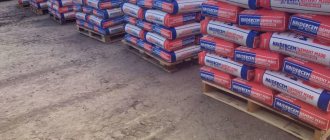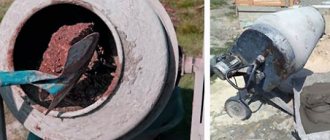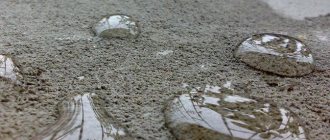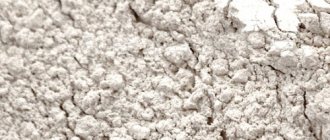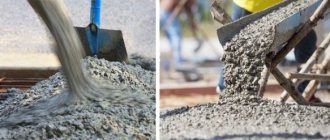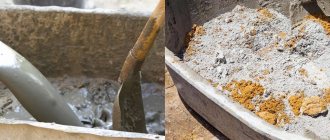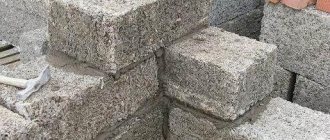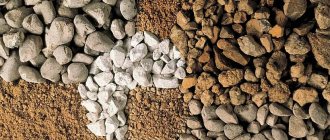What are slag cements and where are they used?
If you grind and mix cement clinker, gypsum and granulated slag in the correct proportion, you get a hydraulic binder - Portland slag cement. When creating this mixture, the main attention is paid not so much to the physical structure of the raw material, but to its chemical composition. Properly selected basic or acidic slags will provide a high-quality astringent hydraulic effect and stable, complete hardening. Clinker acts as an activator of slag hardening upon contact with water, due to the presence of calcium oxide hydrate.
There is also slag clinker-free cement - it does not contain clinker, and the mass fraction of slag reaches 90%. It is cheaper, but also has a more limited scope: for example, it is not suitable for foundation work.
The production process consists of only two stages:
- Drying the slag to a moisture content of less than 1%. its share in the total ratio of components should not exceed the range of 20-80%.
- Grinding with clinker and gypsum in a mill to a homogeneous fine powder. Mixing also occurs in parallel; the proportion of gypsum should not exceed 5%. When producing mineral powder for asphalt concrete, the same grinding method is used.
Portland cement is distinguished from Portland slag cement by the absence of gypsum in the mixture. The material got its name from the Island of Portland - natural stone is mined there, which PC is very similar to due to its pale gray-greenish tint.
Features of slag cement
It has the following advantages and disadvantages:
- low frost resistance, vulnerable to temperature changes;
- long curing period - up to 12 months. At the initial stages it has extremely low strength; as it hardens, this parameter increases. The final strength is comparable to cement;
- as a result, it requires special conditions or composition for successful hardening. Premature hardening will lead to loss of strength;
- one of the main advantages is resistance to fresh and sulfate waters;
- when hardening, it emits less heat than classic cement.
Advantages and scope
Slag porland cement has deservedly become widespread. It is ideal for the construction of buildings exposed to regular exposure to fresh and mineral waters. It has also proven itself well for multi-storey construction, massive structures and the plinth of building foundations.
The main advantage is the price/quality ratio. Being about 10% cheaper than conventional cement, it is often superior in practicality. If you have enough time, you can save even more by choosing a mixture made from granulated slag - it hardens longer, but is also cheaper.
Slag cement is also popular for solving the following problems:
- construction of monolithic products and prefabricated structures. For this purpose, heat-moisture treatment is often used to accelerate hardening without loss of strength;
- It is rare to find a building on a foundation made of such cement, but the external finishing of the base is often made from it;
- production of masonry and plaster mortars, as well as concrete, reinforced concrete and dry building compounds. Often used as the main substance in the above mixtures;
- slag concrete is intensively used in the creation of reinforced concrete pipes, sleepers and bridge elements.
Significantly lower cost compared to cement: adding slag to clinker eliminates the need for firing, and due to the fact that all components are ground simultaneously, labor savings are achieved. These factors allow the use of cheaper plants with simpler equipment.
Slag solution is not recommended for the construction of buildings subject to alternate freezing and thawing. Also, it cannot be laid at temperatures below +10 o C without artificial heating.
Features and application of Portland cement with slag, reviews from specialists and private builders
Portland slag cement has been used in many areas of construction for almost 200 years. This building material is widely used when constructing above-ground, underground and underwater buildings. Slag cement is a cementitious hydraulic component that is obtained by grinding cement clinker, gypsum and granulated slag.
What is cement with slag? For a long time, granular elements were considered waste, but practice has proven that slag concrete is lighter and more durable. Thanks to materials from the secondary production of waste from the metallurgical industry, gypsum or clay combined with cement make the structures more durable.
Features of mixtures for domestic use
There are many options for using slag and cement in repair and construction work.
But first, it would be advisable to consider the features of such concrete that are most appropriate for individual cases of its use.
Table of setting times for cement with different types of slag.
- As a rule, the features of the mixture produced for exterior and interior decoration differ. If you are going to make a solution based on slag and cement, which you will use to finish the internal surfaces, then you should give preference to coarse-grained slag, of which you need to take about 6 parts. The remaining 4 parts are fine-grained granular slag. Any cement can be used for concrete. For finishing the external facade of a building, it is customary to use the following proportions: approximately 3 parts of fine-grained slag and 7 parts of coarse-grained slag. Cement must be of better quality so that it has sufficient resistance to external atmospheric influences.
- If you need to make a high-quality pour and have enough time left, then you should give preference to non-granulated slag. This mixture will harden noticeably slower, but the result will be a much better coating. After all, cracks will not form on it for a long time, the appearance of which is observed after 1-2 years on a poured cement floor.
- To finish the outer part of a protruding foundation (basement), experts recommend using cement with granulated slag. Moreover, the larger the surface to be finished, the more granules in the slag can be used. And vice versa.
Construction of a cinder block wall.
So, these were the main features of the use of slag and cement in ordinary domestic construction. By following these simple rules, you can achieve a high-quality finish and not regret anything in the future.
At the same time, you have an excellent opportunity to make, at least insignificant, but still save money through a clear choice of specific proportions.
Peculiarities
Slag-alkali cement is made using alkali metals. High strength indicators were obtained by adding various alkaline materials - soda, glass.
Portland cement with cinder block is widely used in the construction of reinforced concrete structures, the performance requirements of which must be resistant to aggressive chemical substances. These concrete mixtures are indispensable for the installation of monolithic buildings. When Portland cement is used in the construction of large elements, a large amount of heat is generated in the process and at this moment the temperature reaches up to 80 degrees C. If the structure is cooled in a short period, there is a possibility of the formation of deformation cracks. Slag-alkaline concrete does not allow such a problem to arise.
The most common class of Portland cement, with slag, is based on a combination of alkali metal with Calcium hydrosilicate, hydroalumina silicate and crushed metallurgical slag. Structures made from such building materials have minimal porosity. High quality minimizes water absorption and increases resistance to low temperatures. After 24 hours, the building material reaches 30% strength.
What is it - cement with slag, its use, proportions for concrete
Cement with slag is a building material used in many areas for the construction of above-ground/underground and underwater structures. It is a cementitious hydraulic component produced by grinding cement clinker, slag granules (20-80%, but optimally 50%) and gypsum (maximum 5%).
For quite a long time in the construction industry, granulated slag was considered a waste, but then they began to use slag concrete, appreciating their durability and lightness. Recycled materials, the so-called waste from the metallurgical industry, with the addition of clay, gypsum, mixed with cement, give the structure increased strength.
Slag cement has found wide application in the construction of reinforced concrete structures, where high levels of resistance to aggressive chemicals have been established. These concrete mixtures are relevant for the installation of monolithic buildings. Thus, in the case of using conventional cement in large structures, a significant amount of heat is generated, which during rapid cooling can cause the appearance of deformations and cracks. When using slag concrete this problem does not arise.
The most common cement with slag is created from a combination of alkali metal and hydrosilicate Calcium, in tandem with hydrosilicate and fine metallurgical slag. Structures made from this material provide minimal porosity. Due to the high quality, hydro absorption is minimal and resistance to low temperatures is maximum. Within a day, the material gains about 30% of the standard strength.
Specifications
According to GOST 1017-85, Portland slag cement includes the following components and technical conditions:
- Clinker should contain no more than 5-6% magnesium, since this element can reduce the quality characteristics of concrete.
- Slag in granules obtained by blast furnace or electrothermometamorphic methods - approximately 20-80% (depending on what characteristics are needed).
- Minerals of gypsum origin are pure gypsum, extracted naturally with the addition of phosphorus and fluorine, but not more than 5 percent of the total volume of clinker.
ShPC is divided into two types - normal-hardening and rapid-hardening. Special additives are added to the second material, which are accelerators of mineral and volcanic origin - ash, pumice. Slag concrete has the following proportions: 4-5 parts slag, 2 parts cement, 2 parts sand. The strength of such products is achieved within 1-2 weeks.
Concrete based on metallurgical slag does not tolerate temperature changes, so the material will harden for a long time in cool conditions. To speed up the process, special additives are used or the structure is treated with heat using thermal pads or electrically heated formwork. When exposed to high temperatures, concrete will gain strength in 28 days. The binder has the following qualities:
- if the composition includes a large amount of slag, the longer the concrete mixture will harden and the less heat will be released during hydration;
- slag cements shrink in the same way as Portland cement;
- heat resistance of ShPC is from 600 to 800 degrees C;
- cement on slag in the absence of active substances and dense molecular consistency after hardening will not react with water. This material is indispensable for the construction of structures in wet conditions.
The shelf life of slag Portland cement is much lower than that of conventional dry cement mortar. The material is usable for about 45 days from the date of shipment from production. It is strictly not recommended to use expired building materials, as they lose their strength and waterproof qualities.
Portland cement and Portland slag cement have the following differences:
- The cost of Portland cement is much higher than the usual ShPC mixture.
- Portland cement becomes strong faster, and concrete with slag after 21 days.
- The Portland cement composition does not contain slag; it contains clinker and a certain mineral composition with special accelerator additives.
- ShPC has a less pronounced exothermic reaction during the hardening process; the concrete mixture hardly heats up, this in turn brings difficulties at temperatures below +4 degrees C.
- Portland slag cement has a lower density and weight of finished structures.
Systematization of Portland cement with slag
Portland cement class 300 according to GOST 10178-85
| Trait | Index | |
| 1 | Material composition of cement, %: - granulated blast furnace slag - Portland cement clinker - gypsum stone | 50-6040-501,5-3,5 |
| 2 | Ultimate strength (3 days of hardening) - in bending, MPa - in compression, MPa | 3,0-3,512,0-13,0 |
| 3 | Mass fraction of: - free calcium oxide, % - magnesium oxide in clinker, % | Least 0.5 Least 1.6 |
| 4 | Activity during steaming - during torsion, MPa - during compression, MPa | 3,8-4,222,0-23,5 |
| 5 | Ultimate strength (28 days of hardening) - in bending, MPa - in compression, MPa | 5,2-5,533,5-34,0 |
| 6 | Start of setting no earlier than, hour/min | 3-10 |
| 7 | Grinding fineness (through sieve 008), % | 90,0 |
| 8 | End of setting no earlier, hour/min | 4-40 |
Portland cement class 400
| Trait | Index | |
| 1 | Material composition of cement, %: - granulated blast furnace slag - Portland cement clinker - gypsum stone | 38-4058-621,5-3,5 |
| 2 | Ultimate strength (3 days of hardening) - in bending, MPa - in compression, MPa | 3,0-3,512,0-13,0 |
| 3 | Mass fraction of: - free calcium oxide, % - magnesium oxide in clinker, % | Least 0.5 Least 1.6 |
| 4 | Activity during steaming - during torsion, MPa - during compression, MPa | 4,1-4,325,0-26,0 |
| 5 | Ultimate strength (28 days of hardening) - in bending, MPa - in compression, MPa | 5,8-6,041,4-42,5 |
| 6 | Start of setting no earlier than, hour/min | 3-00 |
| 7 | Grinding fineness (through sieve 008), % | 90,0 |
| 8 | End of setting no earlier, hour/min | 4-20 |
Portland cement class 500
| Trait | Index | |
| 1 | Material composition of cement, %: - gypsum stone - Portland cement clinker | 2,0-2,5100 |
| 2 | Ultimate strength (3 days of hardening) - in bending, MPa - in compression, MPa | 4,5-4,825,0-27,0 |
| 3 | Mass fraction of: - free calcium oxide, % - magnesium oxide in clinker, % | Least 0.5least 1.5 |
| 4 | Activity during steaming - during torsion, MPa - during compression, MPa | 4,3-4,631,0-34,0 |
| 5 | Ultimate strength (28 days of hardening) - in bending, MPa - in compression, MPa | 6,3-6,550,5-52,0 |
| 6 | Start of setting no earlier than, hour/min | 2-32 |
| 7 | Grinding fineness (through sieve 008), % | 90,0 |
| 8 | End of setting no earlier, hour/min | 3-43 |
Advantages
The main advantage of Portland slag cement is its low cost when compared with Portland cement. The most pronounced positive qualities of ShPC:
- The low specific gravity and density of the finished products do not create much pressure on the foundation and floors.
- The material is heat-resistant, the heating range can be 600-800 degrees C.
- This class of cement is most suitable for constructing structures in humid conditions. For example, Portland cement M 400 with slag contains from 21-35% granulated blast furnace material.
What is cement with slag used for and how to make a solution?
Cement with slag is an artificially produced hydraulic substance with a pronounced astringent effect. It is somewhat analogous to Portland cement. Its main feature is that it contains finely ground waste from the metal industry, namely slag.
Flaws
Portland cement with slag has one drawback - if the tightness of the bags is broken, the strength properties will be lost 45 days after the date of manufacture.
Cement manufacturers can also add mineral additives in accordance with regulations and construction rules. Do not be afraid of concrete with the addition of slag; it is recommended to choose a brand that will suit the task.
Reviews
According to reviews and recommendations from professionals and private builders, slag-alkaline concrete has a well-chosen composition that allows the construction of reliable and durable structures. Many craftsmen note that the solution has reasonable prices and convenient packaging; it is quite easy to work with it. The goods are easy to deliver to the construction site and unload. The material fully complies with quality standards, for this reason the structures are durable and strong.
Lightweight concrete made from a mixture of cement, sand and slag has only positive characteristics. In addition to reasonable price and ease of use, the building material has high density of finished structures, water resistance, and frost resistance.
Slag cement is a highly effective and durable mixture that is widely used in the construction industry. Depending on the needs, you can change the proportions of the components in the cement mixture in order to achieve the best result and quality.
Source


